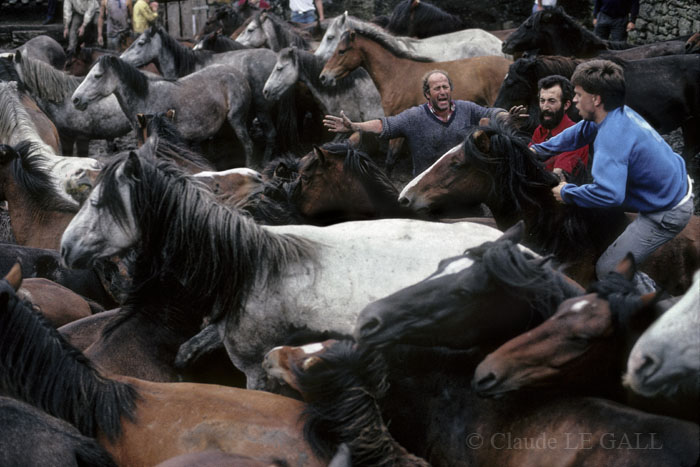Protagonists: Bestas and Aloitadores

As Bestas: The Wild Soul of a Purebred Galician Horse
The Purebred Galician Horse (PRG), traditionally known as “besta” in Sabucedo, is a subtype of small horse that lives in the mountainous areas of Galicia. Despite its life in the wild, it has a gentle temperament, which makes it ideal for therapeutic riding.
In this context, it’s worth noting that “besta” is the term used for mares, which are the main asset of Sabucedo. In each herd, there can be several “bestas” but only one stallion. The dominant stallion of each herd is called a “garañón.” According to some zoologists, this breed is actually the ancestor of today’s domestic horses and is known as a garrano in Portugal.
The origin of this breed dates back to the Celts, who introduced a domesticated pony to the northern part of the peninsula. Over time, it differentiated into several similar breeds found along the European Atlantic coast, maintaining a close relationship with breeds like the Jaca Navarra and the Pottoka. These horses, which are incredibly resilient to bad weather, form a very sensitive ecosystem
The Purebred Galician Horse (PRG) is a breed with a docile, brave, and intelligent temperament, featuring a straight profile, a light weight (165-300 kg), and a brown or black coat. Physically, it has a proportional head with small ears and large, expressive eyes. Its body has a neck with an abundant mane, a prominent withers, and a straight topline. Its limbs are slender, short, and strong, with small, hard, dark hooves. Their manes and tails are very thick, and sometimes they have hair on their upper lip and chin.
The Aloitadores: The Person-to-Person Tradition
The figure of the “aloitador” is the essence of the Rapa. They are the people who, with their skill and courage, confront the bestas in the curro in a body-to-body struggle. The work of the aloitador isn’t limited to the Rapa; throughout the year, the people of Sabucedo are in charge of monitoring the horses, controlling wolf attacks, and rescuing injured animals.
The “aloitamento” technique is based on a strict code of respect and skill that has been passed down through generations. It involves immobilizing the animal without using any tools, through the coordinated action of a team of three aloitadores. In the “curro,” no horse, no matter how wild, has ever been left un-raped.
This tradition has shown its resilience over time. The Rapa das Bestas has never stopped taking place; even during the Spanish Civil War, when the men were fighting on the front lines, it was the women of the village who took charge and continued it. Today, the growing presence of female aloitadoras ensures that this tradition is inclusive and remains alive.




